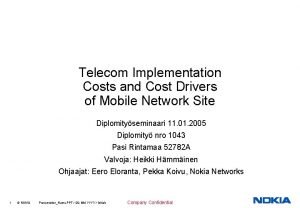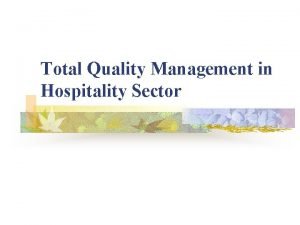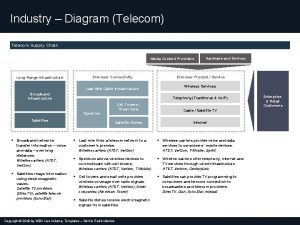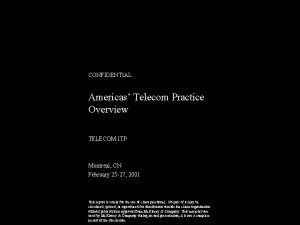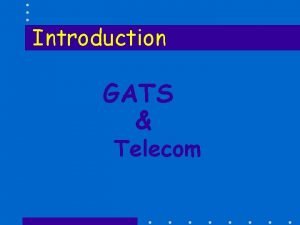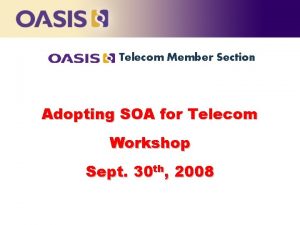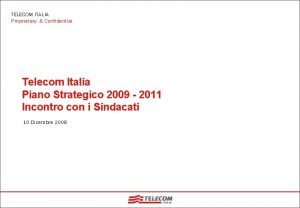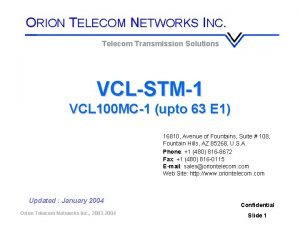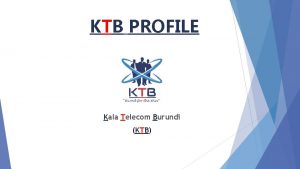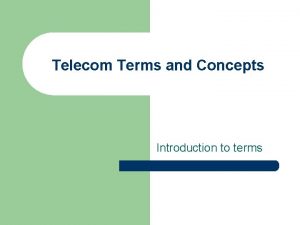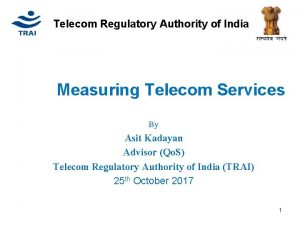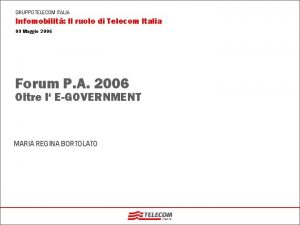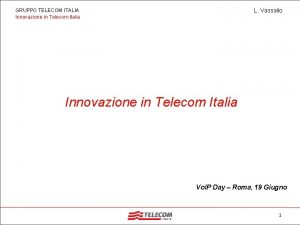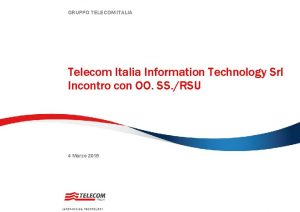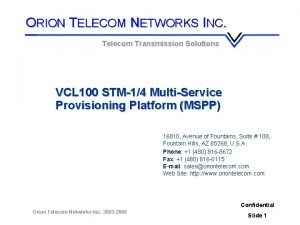Telecom industry overview Facts of the industry Total
























- Slides: 24



Telecom industry overview…. . Facts of the industry: Ø Total telecom subscribers: 906. 93 (at the end of September 2011) Ø The tele density in India has reaches 67. 67% during January 2011 Ø Urban: 150. 67% Ø Rural: 32. 11 % Ø According to the latest report released by Telecom Regulatory Authority of India (TRAI), Ø India has 538. 38 million Urban Subscribers Ø 267. 74 million Rural subscribers. Ø The mobile growth in rural areas is higher at 3. 07% as compared to urban which was about 2. 06% in January. Ø One of the biggest telecom market in the world. Ø The average revenue per user (ARPU) Ø GSM-Full Mobility service declined by 10. 16%, from Rs 122 to Rs 110 (2. 46 USD), decrease of 33. 1%. Ø CDMA – full mobility service declined by 1. 34%, from Rs 74 to Rs 73 (1. 63 USD. Hence declined by 17. 5%.

Telecom industry overview…. . The following bar chart depicts the revenue from the various telecom services for the financial year 2010 -2011. Telecom service revenue (Cr. ) Rs. 120, 000. 00 1, 02, 230 Rs. 100, 000. 00 Rs. 80, 000. 00 Rs. 60, 000. 00 6, 846 11, 602 3, 951 er Rs. 20, 000. 00 at o Rs. 40, 000. 00 r 22, 607 ec om te l ic bl Pu Br oa db an d ILD e lin Fix ed Ce llu la r op Rs. 0. 00 Telecom service revenur (Cr. )

Telecom industry overview…. . Telecom revenue for the year 2010 -2011: ØThe India telecom industry expected to grow at a compound annual growth rate (CAGR) of 15. 8 per cent between 2010 and 2014 and will touch revenues of Rs. 3, 77, 683 Crore ($ 82 billion). ØThe India telecom services and mobile handsets market will grow at 16. 7 per cent in 2012 (over 2011) and will touch revenues of Rs. 2, 88, 832 Crore Ømobile and fixed line services will contribute Rs. 2, 05, 454 Crore Ø the India mobile handsets market which includes feature phones and smart phones will contribute Rs. 83, 377 Cr. . ØThe revenue contribution from the public sector telecom companies in 2010 -11 was 20. 37% (previous year 24. 82%) and from private sector firms was 79. 63% (previous year 75. 18%).

KEY PLAYERS…

There are 3 types of players in the telecom industry State owned companies • MTNL • BSNL Private Indian owned companies • Reliance infocomm • Tata Teleservices Foreign invested companies • • • Vodafone Airtel Docomo Aircel Videocon etc.

The top 10 players of the Indian telecom industry are : 1. Reliance Comm. Ltd 2. Bharti Airtel Limited 3. BSNL 4. MTNL 5. Vodafone Essar 6. Idea Cellular Limited 7. Aircel 8. Videocon 9. Uninor 10. Tata Teleservices

Telecom operators revenue market share march 2011 ØAccording to TRAI’s report , gross revenue grew 4. 1% in 4 QFY 11 vs. 4. 9% in 3 QFY 11. ØBSNL gained the highest (+49 bps revenue share), followed by Idea (+29 bps), and Tata Tele (+18 bps) ØBharti (-111 bps) and RCOM (59 bps) lost share during the quarter.

Telecom operator market share:

Top telecom operators in India in accordance to the subscribers base: Operator 1 2 3 4 5 6 7 8 9 10 11 12 13 14 15 Subscriber base Bharti Airtel Reliance comm. Vodafone 17. 08% BSNL Tata Teleservices Idea Aircel Unitech Loop Sistema MTNL Videocon Stel Etisalat HFCL Infotel All India Market Share 146, 293, 078 21. 34% 119, 351, 438 17. 37% 118, 038, 438 80, 739, 935 80, 817, 298 76, 023, 551 47, 519, 629 13, 748, 300 3, 009, 445 7, 121, 765 5, 342, 039 5, 616, 152 1, 867, 060 70, 829 1, 132, 477 11. 31% 11. 47% 10. 84% 6. 64% 1. 05% 0. 45% 0. 86% 0. 81% 0. 43% 0. 22% 0. 01% 0. 13% 706, 691, 164 100. 00 Ø Bharti Airtel remains the market leader with 21. 34% share. ØVodafone Essar and reliance communications is catching up close on 2 nd position with 17308% & 17. 37% and Bsnl is on 3 rd spot with 11. 31%.


Regulatory framework: ØThe Department of telecommunications (Government of India) is the main governing body for the industry. ØTelephone Regulatory Authority of India (TRAI) assists the Government of India (Go. I) to take timely decisions and introduce new technologies in the country. Framework of Indian telecom industry Indian Govt. bodies Wireless planning coordination (WPC) Department of telecommunication Telecommission Group on telecomm and IT Independent bodies Telecom Regulatory Authority of India (TRAI) Telecom Disputes Settlement and Appellate Tribunal (TDSAT)

Important regulations: 1. Unified Access Service License Regime (UASL) ØUnified licensing marked the end of the license regime in the Indian telecom industry. ØEliminated the need for different licenses for different services. Players are now allowed to offer both mobile and fixed-line services under a single license after paying an additional entry fee. Ø Does not take into account national and international long-distance services and Internet access services.

Contd…. . 2. Access Deficit Charges (ADC) ØADC makes it mandatory for a service provider at the caller’s end to share a percent of the revenue earned with the service provider at the receiver’s end in longdistance telephony. ØThis subsidises the infrastructure costs of the service provider enabling access at receiver’s end, especially because rental for fixed-line services is low. 3. Universal Service Obligation (USO) ØAll telecom operators are bound to contribute 5 percent of their revenues to this fund. This system was put in place to bridge the wide gap between urban and rural tele density. ØAlthough it increases the cost burden for the telecom companies, USO helps in building the telecommunication infrastructure in the rural areas.

Emerging trends

TRENDS Mergers and Acquisitions FDI

Mergers and Acquisitions: Following were the mergers and acquisitions that took place: Vodafone purchased stake in Hutch from Hong Kong's Hutchison Telecom International for USD 11. 08 billion. Reliance Communications Limited has sold 5% equity share capital of its subsidiary Reliance Telecom Infrastructure Limited to international investors across the US, Europe and Asia. The deal was worth USD 337. 5 million. Telekom Malaysia acquired a 49 percent stake in Spice Communications for USD 179 million.

Contd… Maxis Communications acquired a 74% stake in Aircel for USD 1. 08 billion. Ericsson to design, plan, deploy and manage Bharti Airtel network and facilitate their expansion in the rural areas, under a USD 2 billion contract.

FDI ØIndia's telecom sector received FDI of Rs. 48, 220 crore in the last 11 years - 8 percent of the total FDI the country received i. e. Rs. 5, 80, 722 crore. ØForeign direct investment in telecom sector in India has increased by 49. 9 percent to $1988. 7 million during April -December 2011 against $1326. 7 million in same period previous year.

INVESTMENT

Investment- Telecom Sector ØThe telecom sector witnessed over 17% increase in investment in 2010 -11 over the previous financial year, an annual report of the Telecom Regulatory Authority of India (Trai) said. ØThe capital employed in the telecom sector increased to Rs 3, 37, 683 crore in 2010 -11 from Rs 2, 86, 837 crore in 2009 -10. ØThe growth in subscriber base resulted in an increase in the gross revenue of telecom services for the year to Rs 1, 719 crore during the year, a growth of 8. 69% from Rs 1, 57, 985 crore in the previous year. ØCapital employed of public sector companies decreased by 7. 35% in 2010 -11.

ØThe telecom sector is attracting significant domestic and global investment. ØThe capital investment made by the telecom service industry during 2010 -2011 comes up to figure of 3, 37, 683. ØThe margins and profits of almost all the telecom companies have been increasing. ØIn fact there are cases where a significant portion of profit of international telecom companies have been from their operations in India.

 Telecom industry overview
Telecom industry overview Kustannusanalyysi
Kustannusanalyysi Apple industry overview
Apple industry overview Why consulting
Why consulting Pasivo total sobre activo total
Pasivo total sobre activo total Total revenues minus total costs equals
Total revenues minus total costs equals Total revenues minus total costs equals
Total revenues minus total costs equals Total revenues minus total costs equals
Total revenues minus total costs equals Total revenue minus total expenses
Total revenue minus total expenses What is total quality management in hospitality industry
What is total quality management in hospitality industry 64:8+9:9-63:7
64:8+9:9-63:7 Hát kết hợp bộ gõ cơ thể
Hát kết hợp bộ gõ cơ thể Slidetodoc
Slidetodoc Bổ thể
Bổ thể Tỉ lệ cơ thể trẻ em
Tỉ lệ cơ thể trẻ em Voi kéo gỗ như thế nào
Voi kéo gỗ như thế nào Chụp tư thế worms-breton
Chụp tư thế worms-breton Chúa yêu trần thế
Chúa yêu trần thế Môn thể thao bắt đầu bằng từ đua
Môn thể thao bắt đầu bằng từ đua Thế nào là hệ số cao nhất
Thế nào là hệ số cao nhất Các châu lục và đại dương trên thế giới
Các châu lục và đại dương trên thế giới Công thức tính thế năng
Công thức tính thế năng Trời xanh đây là của chúng ta thể thơ
Trời xanh đây là của chúng ta thể thơ Mật thư tọa độ 5x5
Mật thư tọa độ 5x5 Phép trừ bù
Phép trừ bù

